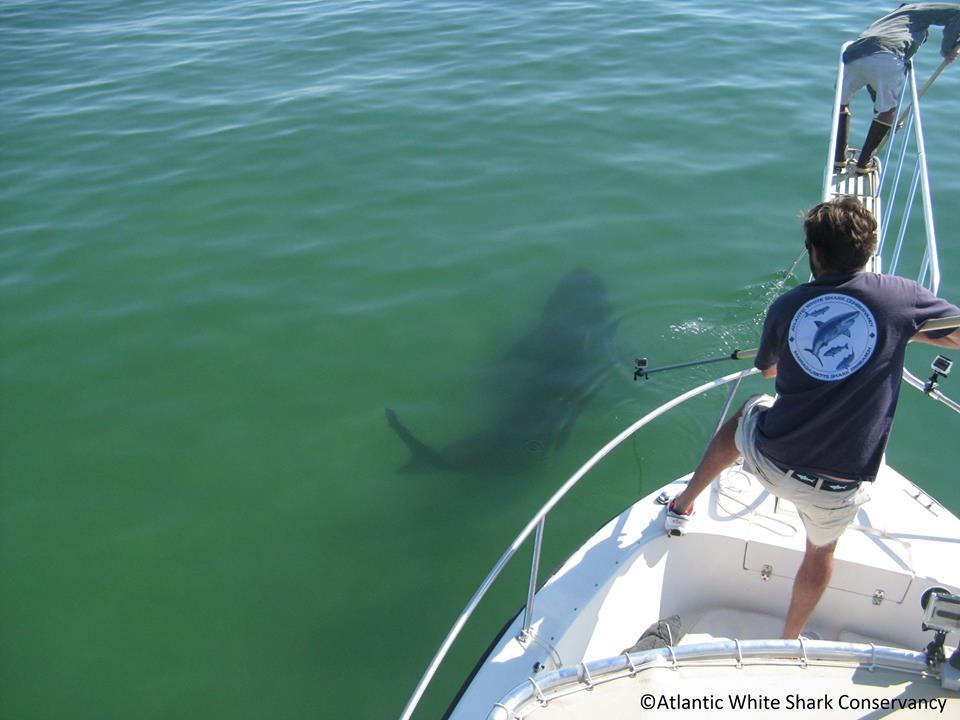

Tracking Great White Sharks in the Gulf of Maine
Melayna Limardo
How do they work?

A white shark is being tagged using a telescoping tag stick. Image Credit : Atlantic White Shark Conservancy
Acoustic Receivers are monitoring devices that listen for specific sound wavelengths. When these soundwaves are detected a data point is stored and categorized under a unique ID.
If the receiver is an underwater device, oftentimes it is moored to the seabed and retrieved using a simple acoustic release mechanism. After retrieval, the data is collected and analyzed with specialized software.
When tracking aquatic animals acoustic telemetry is an extremely useful tool. The animal is tagged using a telescoping tag stick, which penetrates the animal and attaches an external acoustic tag. This tag gives off an unnatural and unique high pitched soundwave that, when in proximity to a receiver, identifies the tag ID, the individual animal, and who tagged the animal.

A white shark with an acoustic tag attached to the dorsal side of its body Image Credit : Massachusetts Division of Marine Fisheries
Why do we need them?
Marine ecosystems are incredibly delicate when it comes to any slight changes that may occur and environmental impacts. It is imperative that scientists monitor these changes in species' behaviors and populations to ensure the welfare of all marine wildlife.
Currently, we are seeing a significant environmental impact due to climate change in the Gulf of Maine.
A temperature anomaly map that shows how drastically regions within our global oceans have warmed/cooled since 1992.
We can see in the map above that the entirety of the Gulf of Maine shows an overall increase in temperature since 1992. This can have detrimental effects on some of the native wildlife, such as whales, which are directly impacted by the decline in zooplankton productivity.
However, a warming ecosystem may also mean an increase in certain marine animals...
Sharks in the Gulf
Great white shark Image Credit : Getty Images
One shark species that we have seen evidence of an increased population in the Gulf of Maine is the great white shark (Carcharodon carcharias).
These sharks are often associated with a 1970s film and suspensful background music, and it was for this reason that they were culled and overfished nationwide for so many years.
It has taken nearly five decades until we have finally begun to see their population numbers rebound and, even though they might look scary, they are actually an important bioindicator of a healthy marine ecosystem!
However, we are not only seeing their numbers increase in their traditional habitats, but we are also seeing a migration in their preffered habitat. With the species being more inclined to reside in temperate waters ranging from 60-71 degrees Farenheit, warming waters in the Gulf are allowing sharks to migrate further North in search of food.
An aggregation of harbor seals Image Credit : The New York Times
Seals are a top choice prey species for white sharks and a greater abundance of seals will often attract a greater number of sharks. In 1972 the Marine Mammal Protection Act effectively banned seal culling and the population numbers have rebounded since. The increase in white sharks is a strong indicator of rising seal numbers.
Seal hotspots detected in the Gulf of Maine
There are legitimate safety concerns that arise when we think of seals attracting white sharks to our Maine coasts. In fact, the first ever deadly shark attack in Maine occured in 2020, which caused panic in many residents and tourists in the area and made the question of whether seals should be culled again to arise. So, it is important that we gain knowledge about white shark populations and distribution in these areas.
Placing acoustic receivers in areas that we know have seal presence may give us some crucial insight into shark patterns. In the map on the right we can see some hotspots along the Maine coast that represent seal aggregation sizes.
If we can detect shark patterns, hotspots, distribution, and population assesments in the Gulf we can effectively warn beach goers about natural predators in the water and prevent tragic accidents from occuring that severely damage the public view of a keystone species.
Maine began adopting similar shark warnings and shark flags seen in Cape Cod after the attack in 2020 Image Credit : Boston Herald
Placing Receivers
Suitable areas for placement of acoustic receivers that are detecting white sharks in the Gulf of Maine
Testing the predictions
Because of the concerns that arose after the 2020 attack, in 2021 the Maine Department of Marine Resources (DMR) deployed 31 new acoustic receivers.
The DMR map of the 31 acoustic receivers monitoring white shark activity that were placed between York and Boothbay Harbor Image Credit : Maine Department of Marine Resources
After creating the suitability map I tested the analysis by comparing whether the point locations fell within my predicted highly suitable areas.
One cluster of receiver points that stands out in the DMR map is near Scarborough Beach. Let's zoom in on this point and some others to see if they are within the predicted suitable areas.
Find the deployed receiver locations using the buttons below or search using the map search tool
Choosing new receiver locations
The coasts and waters surrounding Swan's island has a high density of seals, and it is the second most suitable location I found.
On the map we can see the highest suitable locations in darker green, medium suitability in yellow, and low suitability in orange or red.